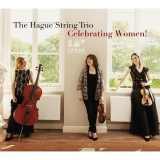Alle vier Stücke dieser CD sind Ersteinspielungen, so dass allein das schon zu Erwartungen führt. Von den vier komponierenden Damen, die von drei musizierenden gespielt werden, ist Ethyl Smyth wohl die namhafteste bei diesen Werken aus der zweiten Hälfte des 19. bzw. der ersten des 20. Jahrhunderts. Doch auch die anderen drei zeichnen sich durch eine klare eigene musikalische Handschrift aus.
Miriam Hyde schrieb sie hauptsächlich in einem impressionistisch bis postromantischen Stil. Ihr Streichtrio aus Studienzeiten in London zeigt schön kombinierte Themen mit rhythmischen und melodischen Kontrasten, aber auch große Gefühlstiefe. Es endet in einer lebhaften und kraftvollen Gigue.
Emmy Frensel Wegener schuf französisch inspirierte Kammermusikwerke. Die Suite für Streichtrio ist eines ihrer frühesten Werke. Die Suite hat die Atmosphäre eines kurzen spritzigen Bühnengeschehens. Sie selber schrieb dem Werk den Charakter eines Divertimentos zu, dessen fünf Sätze abenteuerlich, launisch und bezaubernd klingen.
Im Streichtrio von Ethyl Smyth sind Einflüsse von Brahms erkennbar, aber vorherrschend ist eine starke und eigenständige musikalische Persönlichkeit. Während das Scherzo und der Mittelteil des zweiten Satzes farbenreiche Themen für die spezifischen Klangmöglichkeiten des Streichtrios bringen, überzeugen die beiden letzten Sätze mit melodischen und harmonischen Ideen inklusive volkstümlicher Anklänge.
Die Fuge für Streichtrio von Irene Britton Smith, wahrscheinlich als Übung verfasst, lebt neben der technischen Beherrschung des Werktypus von der beeindruckenden und tiefgründigen Komposition.
The Hague String Trio hat nach ihrer CD mit verfolgten jüdischen Komponisten lässt nunmehr eine entspanntere Seite anklingeln. Doch wiederum gelingt es ihnen, sich die Stimmen der vorgestellten Komponistinnen zu Eigen zu machen und deren Musik die ebenso seriösen wie beschwingten der Stücke auszuloten und in trauter technischer Harmonie des Ensembles zu präsentieren. Wiederum heben sie in ihrer eingespielten Besetzung Unbekanntes, aber Hörenswertes an die Ohren und bereichern damit den Katalog.
Das Beiheft gibt nach einer Einleitung zu diesem CD Projekt kurze wertvolle Informationen zu den Komponistinnen und ihren Werken sowie zum Ensemble. Der Aufnahmeton ist passend zu den Kompositionen transparent und leicht.
All four pieces on this CD are premiere recordings, so that alone leads to expectations. Of the four composing ladies played by the also female trio, Ethyl Smyth is probably the most notable in these works from the second half of the 19th century or the first of the 20th. But the other three are also distinguished by a clear musical signature of their own.
Miriam Hyde wrote them mainly in an impressionistic or post-Romantic style. Her string trio, written in her student days in London, features beautifully combined themes with rhythmic and melodic contrasts, but also great depth of feeling. It ends in a lively powerful gigue.
Emmy Frensel Wegener created French-inspired chamber works. The Suite for String Trio is one of her earliest works. The suite has the atmosphere of a short splashy stage event. She herself attributed to the work the character of a divertimento, whose five movements sound adventurous, whimsical, and enchanting.
Influences of Brahms are evident in Ethyl Smyth’s string trio, but a strong and independent musical personality predominates. While the scherzo and the middle section of the second movement bring colorful themes for the specific tonal possibilities of the string trio, the last two movements are convincing with melodic and harmonic ideas including folk echoes.
Irene Britton Smith’s Fugue for String Trio, probably written as an exercise, thrives on its impressive and profound composition in addition to its technical mastery of the work type.
After their CD of persecuted Jewish composers, The Hague String Trio now turns to a more relaxed music. But again they succeed in making the voices of the featured female composers their own, exploring the music of the pieces, which are as serious as they are upbeat, and presenting them in the ensemble’s trusting technical harmony. Again, in their recorded instrumentation, they lift unknown, but worth hearing works, and thus enrich the catalog.
The booklet, after an introduction to this CD project, provides brief valuable information about the composers and their works as well as the ensemble. The recording tone is transparent and light to match the compositions.
The Hague String Trio: Streichtrios aus dunklen Zeiten mustergültig beleuchtet






















